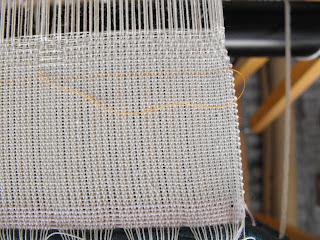For the warp I used a 2/16 natural cream cotton set at 36 epi so that is close to 900 ends with most of those on harness 1, 2 and 3 because of the plain weave. I had to make some changes to the draft to make it work with my loom as I only have 100 heddles per harness. So I expanded the draft onto 12 harnesses with harness 1 through 7 being the plain weave and 8 through 12 being the pattern harnesses.
I still needed ten extra heddles on harness 1 through 4. Summer and Winter is a heddle pig! So I had to take 40 heddles off harness 12, I don’t really like to move the heddles around on the loom because it hurts my fingers. I call the black pins used to hold the harness on the texsolv system ‘evil penguins’ because they bit my fingers! But I only move heddles once a year so it is OK but if I had to do it more often I think that I would spring for more heddles! The picture is harness 12 being held up by the lease sticks.
The plan for the tea towels is to weave plain weave for the hem in the 2/16 cream cotton. The first three inches in the Christmas Tree pattern in the 2/16 cream cotton. Then weave a stripe of the Christmas trees in green 2/8 cotton. I want the Christmas trees to really pop. The rest of the tea towel will be woven with 2/16 cream cotton in the Christmas Tree pattern to add a texture to the bulk of the tea towels.
I noticed that when I was weaving with the 2/16 cotton that I had large loops on the edges. In the picture you can see that the tension is fine with the 2/8 pink scrap cotton but the 2/16 is too loose.
I use Schacht end feed shuttle so that means that I have to change the tension on the spring plates in the shuttle. To do that there are little screws on the side that you stick in an Allen wrench in and turning clockwise for higher tension. A pro tip is that there are two plates and you have to adjust both of them so small adjustments on both sides! I only adjusted one side and it really affected the draw and I was close to losing the whole plate by pushing the screw out!
Finally ready to weave the pattern for the Christmas trees after a lot of unweaving. I even remembered to flip the pattern before weaving! It is OK but . . .
The selvedges are terrible!
I don’t think that there is much that can be done to save the tea towel project. There is already two inches of plain weave for the selvedge. I was going to do 4 picks of plain weave between each Christmas tree motif but the draw in would make for terrible edges. Also I had only woven about five inches and already some of the pattern threads were drooping which I don’t really get because I had only woven about ½ inch of the Christmas tree pattern. I shudder to think what a mess that I would have ended up with after a full pattern repeat.
So I unwove everything, put the lease sticks back in, untied the cloth bar, pulled the warp out of the reed and the heddles – there is no going back! So now I have to hit the books to find a different draft that is going to work for my Christmas tea towels.
Final Garden Shot. I think that we post a picture of this plant every year because it is absolutely beautiful. It is a Beauty Berry Bush (Callicarpa bodinieri 'Profusion'), the lime green leaves and purple berries makes it the star of the autumnal garden.























